As a school, you may have many pieces of art and specialist items which are entwined with the history of the institution, inspiring a renowned ambience for students, staff and prospective parents. School art collections play an important role in its narrative, often featuring portraits of past alumni, scholars, and pieces connected with famous artists and designers.
Keeping these pieces out of harm’s way, as well as keeping them in their very best condition, is a priority for both their academic and cultural heritage, as well as presenting a well maintained appearance within the grounds and buildings they inhabit.
 Above: a portrait of a boy in a sailor suit with several tears to the canvas, before and after restoration by our team
Above: a portrait of a boy in a sailor suit with several tears to the canvas, before and after restoration by our team
Restoration is not only reserved for fine art and antiques in states of severe deterioration, it can also be performed to prevent or halt issues occuring and lower risks. Protective measures and guidance can be offered to ensure that all pieces are safe and stable, whilst condition reports can offer an in-depth analysis of an artwork for your records.
 Above: an antique map before and after restoration by our expert paper conservator who has removed contamination and creased areas
Above: an antique map before and after restoration by our expert paper conservator who has removed contamination and creased areas
Professional assessments can be arranged which not only consider the condition of the artwork, but also the surrounding area, as suitable levels of light, humidity and temperature, are key in preventing avoidable damage.
We hope that this article will enlighten you upon the ways in which our team at Fine Art Restoration Company can help your team keep the school’s collection in pristine condition.
How can we help?
Our professional conservators work with a wide variety of mediums, their specialities and experience many areas, including (but not limited to) easel paintings, frames, furniture, paper, textiles, interiors, ceramics, and sculptures. Whether an item is severely damaged or simply requires routine maintenance, no task is too big or small for our experts.
 Above: our team collaborating in our studio to share ideas and provide tailored restoration plans and treatments
Above: our team collaborating in our studio to share ideas and provide tailored restoration plans and treatments
Paintings
Our team of trained conservators perform treatments which have been tailored to the specific needs of an artwork. This includes the precise use of specialist solvents and pigments, as well as adhering to a conservation principle which ensures the historic integrity of the artwork is always maintained. We also offer detailed condition reports and scientific analysis of an artwork as an extra service, helping you to properly document each piece as a record for perpetuity.
 Above: our experienced easel painting conservator working on historic oil paintings in our studio
Above: our experienced easel painting conservator working on historic oil paintings in our studio
Oil paintings may face a variety of conditions due to their old age or composition. Whilst historic paintings may discolour due to old varnish or have a perishing paint layer, contemporary artwork may also face natural deterioration connected to the materials and preparation from the artist. We recommend that all paintings, regardless of age, have monthly assessments from your team to check for worsening conditions.
 Above: a Mater Admirabilis painting from Woldingham School in Surrey which underwent restoration by our team in 2021
Above: a Mater Admirabilis painting from Woldingham School in Surrey which underwent restoration by our team in 2021
Accidental damage is a frequent reason behind painting restoration, whether this is through knocks and falls or untrained cleaning attempts. A torn and dented painting can be professionally restored, hiding signs of the disaster and bringing stability back to the paint layer. This will help to maintain the well-kept presentation of the school, as well as preserving a historically or culturally significant artwork.
Mural and fresco paintings may also require restoration due to old age, accidental damages or disasters. Click here to read a case study about a ceiling restoration at Westonbirt School.
 Above: an oil painting fully restored by our team following devastating water damage
Above: an oil painting fully restored by our team following devastating water damage
Paper
Works on paper are very susceptible to their environment, too much light may cause drastic fading, whilst the wrong level of moisture in the air can cause mould damage or brittle decay. Our team can advise on the best presentation techniques for a work on paper, as well as performing conservation techniques to prevent further deterioration and eliminate any risks.
 Above: our ICON accredited paper conservator working on a miniature watercolour portrait
Above: our ICON accredited paper conservator working on a miniature watercolour portrait
Drastic damage to paper, such as a tear, fire damage, or water damage, can also be professionally restored. Our ICON accredited paper conservator can perform wonders on even the most delicate and significantly damaged artworks, including fibre-by-fibre tear repairs and washing of discolouration and surface contamination.
 Above: a historically important almshouse rules document which was expertly restored by our paper conservator
Above: a historically important almshouse rules document which was expertly restored by our paper conservator
Our team also offers a tailored framing service for all artworks, which is important for an artwork such as a print, written document, or watercolour, as we can provide UV protective glass and conservation-appropriate mounting and backing boards free of acidic elements.
 Above: a watercolour painting before and after restoration, including a tear repair and cleaning of discolouration caused by acidic framing materials
Above: a watercolour painting before and after restoration, including a tear repair and cleaning of discolouration caused by acidic framing materials
Sculptures
Indoor and outdoor sculptures may face different levels of risk depending on their location. They may be mostly prone to accidental damage due to their positioning, including breakages and discolouration. Members of our conservation team specialise in mixed media sculptures including papier mache and unusual materials, as well as traditional pieces such as marble and stone.
 Above: a papier mache bull sculpture which was cleaned by our conservators allowing it to be returned to display free of dirt and debris
Above: a papier mache bull sculpture which was cleaned by our conservators allowing it to be returned to display free of dirt and debris
Conservation treatments for sculpture include the reinstatement of missing colours, a professional clean to bring original tones back and to eliminate any environmental contamination, the seamless readhering of broken pieces with conservation appropriate adhesives, and the recreation of missing pieces if required.
Ceramics and metals
Ceramics and metals require specialist attention, as amateur attempts at restoration can often lead to further deterioration – such as the use of superglue or sticky tape which causes yellowing and acidic decay. Our ceramics conservator can remove any old attempts at restoration and restore broken pieces with a seamless outcome. She can also recreate any missing areas of a ceramic ornament or item to give a flawless finish. Our metals specialist can also perform professional cleaning.
 Above: a terracotta figure before and after restoration by our conservator
Above: a terracotta figure before and after restoration by our conservator
Weak points on ceramics and metals can be stabilised with different treatments. With ceramic items you may find that it is a common problem that the extremities of a figurine or design have a weak join, our conservator can place in a strengthening metal bar or wire into the piece to help protect from any recurring damage. The ongoing preservation of metal and ceramic items is all part of the conservation process, our team will always strive to ensure the longevity of such items as well as restoring their current defects.
 Above: a selection of ceramics which have been restored by our specialist conservator
Above: a selection of ceramics which have been restored by our specialist conservator
Textiles
Textiles such as upholstery, rugs, tapestries and embroidery may face damage from their surroundings, especially following a disaster such as a leak or fire. They may also begin to deteriorate due to constant use, their old age, UV rays, or the delicate nature of their materials.
 Above: a peacock tapestry restored by our specialist conservator, cleaning away contamination and mould damage
Above: a peacock tapestry restored by our specialist conservator, cleaning away contamination and mould damage
Our textile conservators can professionally clean a discoloured antique or contemporary item, as well as offer preservation treatments to prevent deterioration. Our team can also offer framing and presentation options to lessen risks posed to such items, including fading from sunlight and to fabric which may be under strain from use or touching.
 Above: an important military cap restored by our textiles conservator
Above: an important military cap restored by our textiles conservator
Interiors and frames
Gilded areas of interior design and ornate frames require as much care as the artworks which inhabit them. A well-kept surrounding will ensure the health of other items in the vicinity, as well as maintaining the presentation of the school to students, staff, and visitors. Our frame conservators can offer stabilisation treatments to any which may be putting their artwork at risk due to cracks or weak joins. Trained members of our team can provide expert gilding to frames and interior elements which may require gold leaf application.
 Above: a frame restored by our conservator, including remoulded areas and reapplication of gilding
Above: a frame restored by our conservator, including remoulded areas and reapplication of gilding
Any lost ornate areas can also be restored with a technique which remoulds existing features and colour-matches them to the original design. Where remoulding is not possible, our experts can use their historical knowledge and artistic skill to recreate a piece entirely, ensuring it is in keeping with the historic integrity of the interior or frame.
 Above: our furniture conservators working with a variety of items in our studio
Above: our furniture conservators working with a variety of items in our studio
Get in touch with our team
If you have any questions or would like to arrange a visit from one of our specialist team, please contact us via email [email protected] or call 0207 112 7576

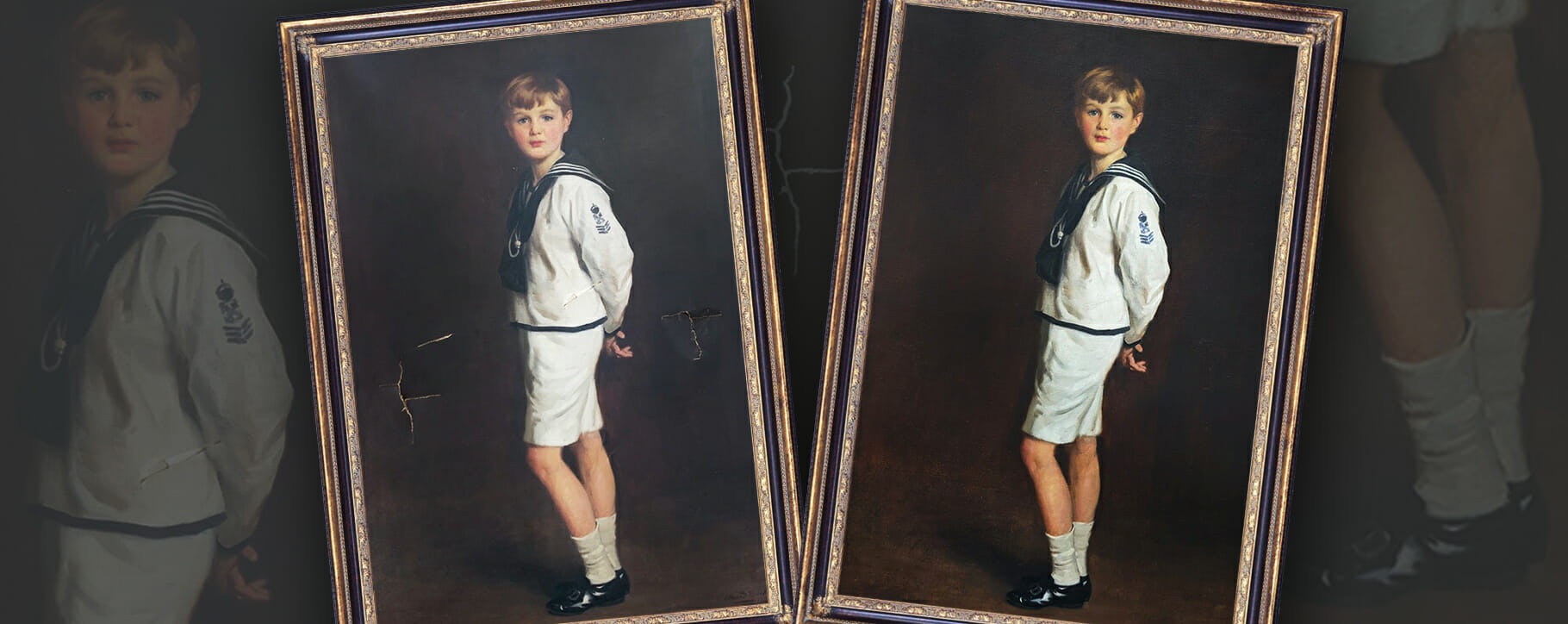 Above: a portrait of a boy in a sailor suit with several tears to the canvas, before and after restoration by our team
Above: a portrait of a boy in a sailor suit with several tears to the canvas, before and after restoration by our team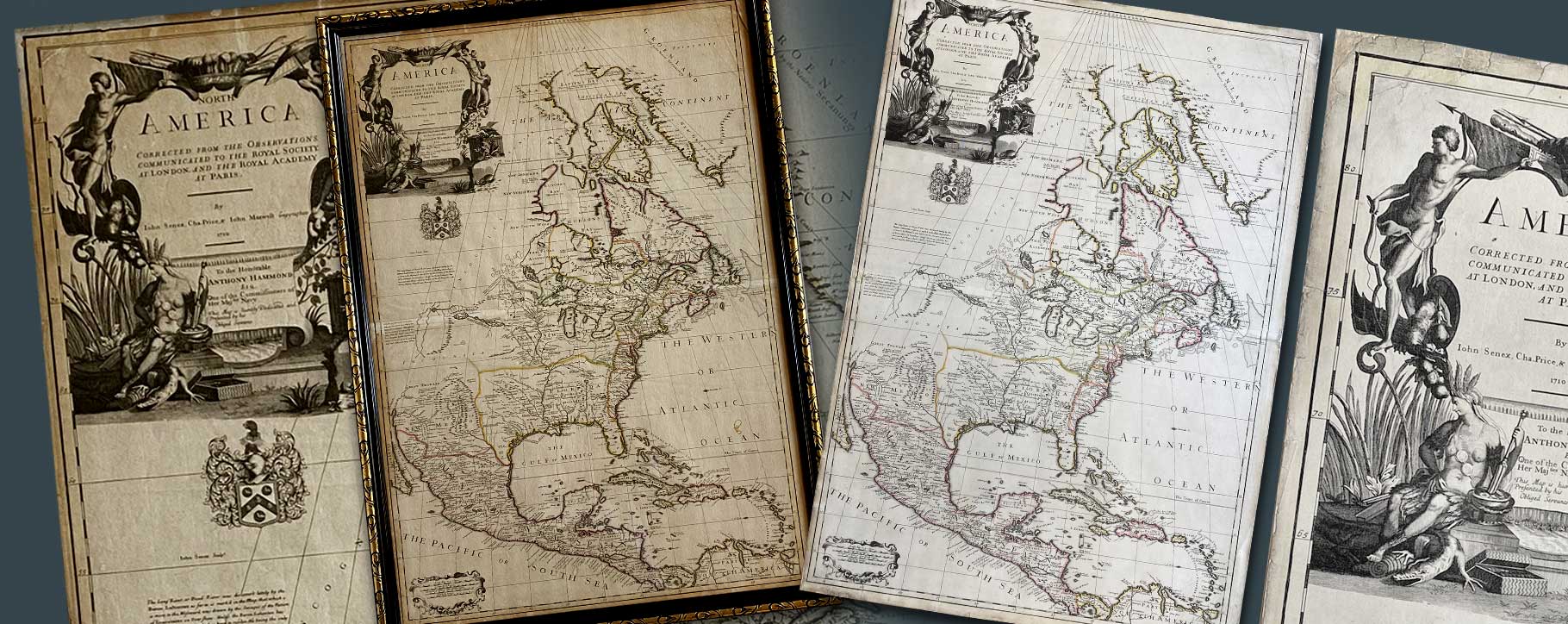 Above: an antique map before and after restoration by our expert paper conservator who has removed contamination and creased areas
Above: an antique map before and after restoration by our expert paper conservator who has removed contamination and creased areas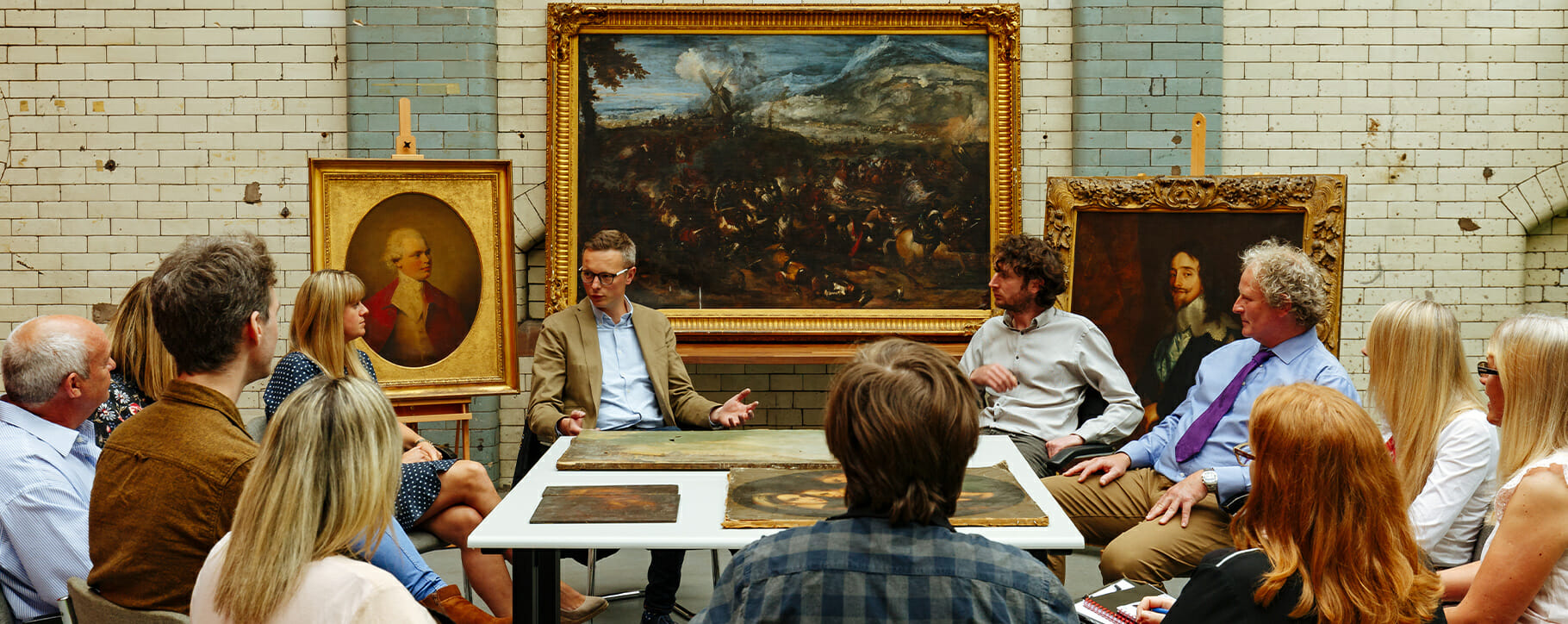 Above: our team collaborating in our studio to share ideas and provide tailored restoration plans and treatments
Above: our team collaborating in our studio to share ideas and provide tailored restoration plans and treatments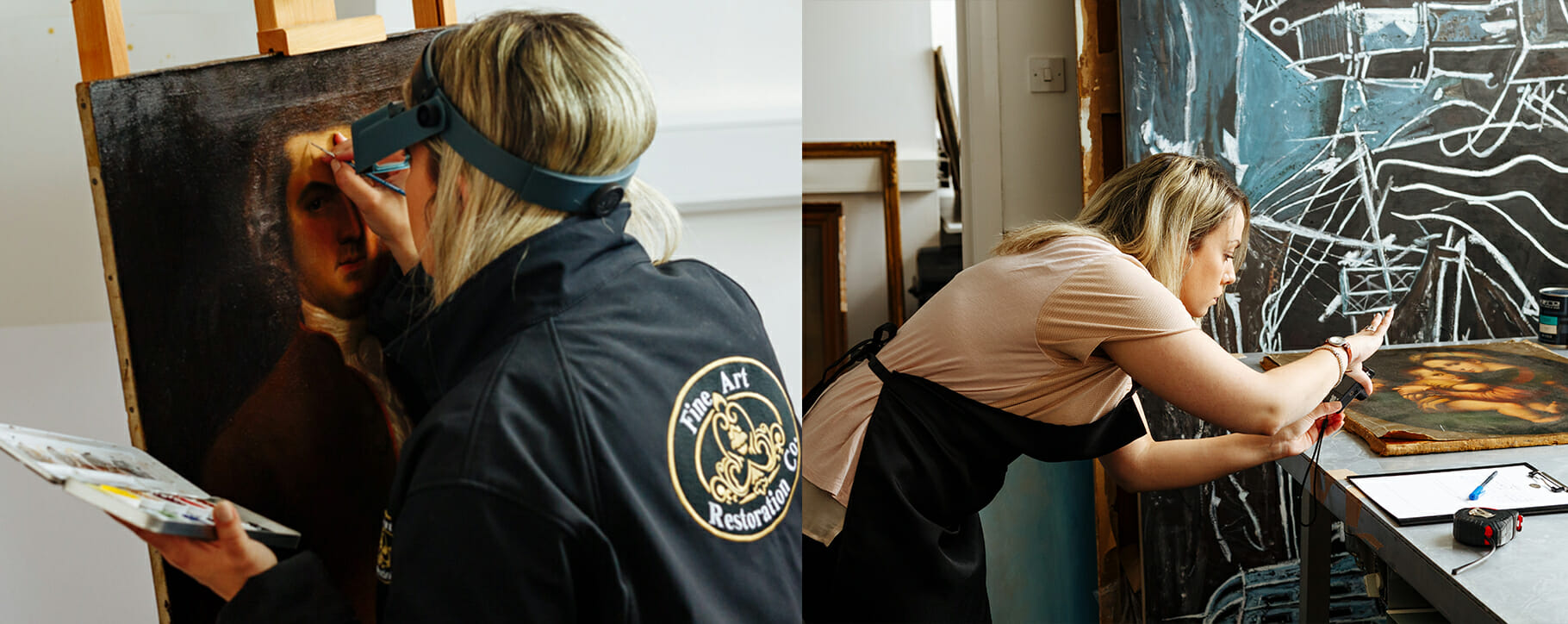 Above: our experienced easel painting conservator working on historic oil paintings in our studio
Above: our experienced easel painting conservator working on historic oil paintings in our studio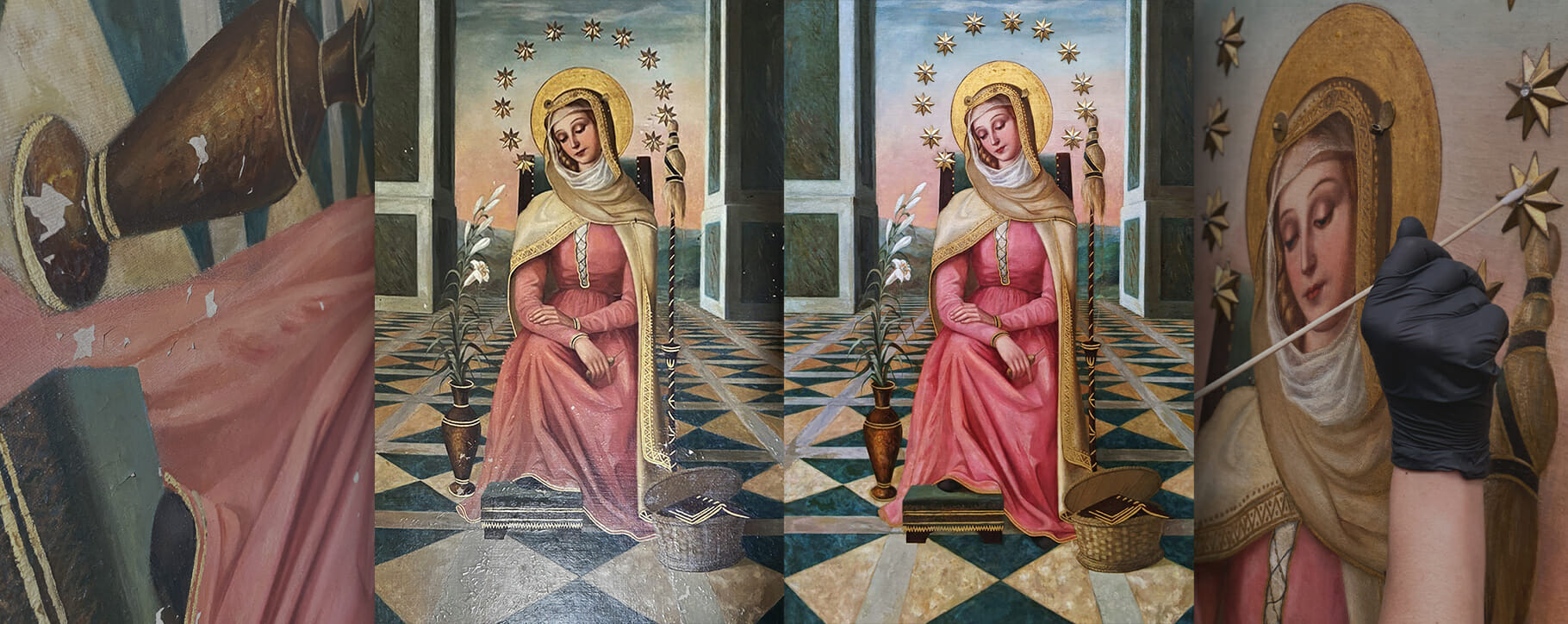 Above: a Mater Admirabilis painting from Woldingham School in Surrey which underwent restoration by our team in 2021
Above: a Mater Admirabilis painting from Woldingham School in Surrey which underwent restoration by our team in 2021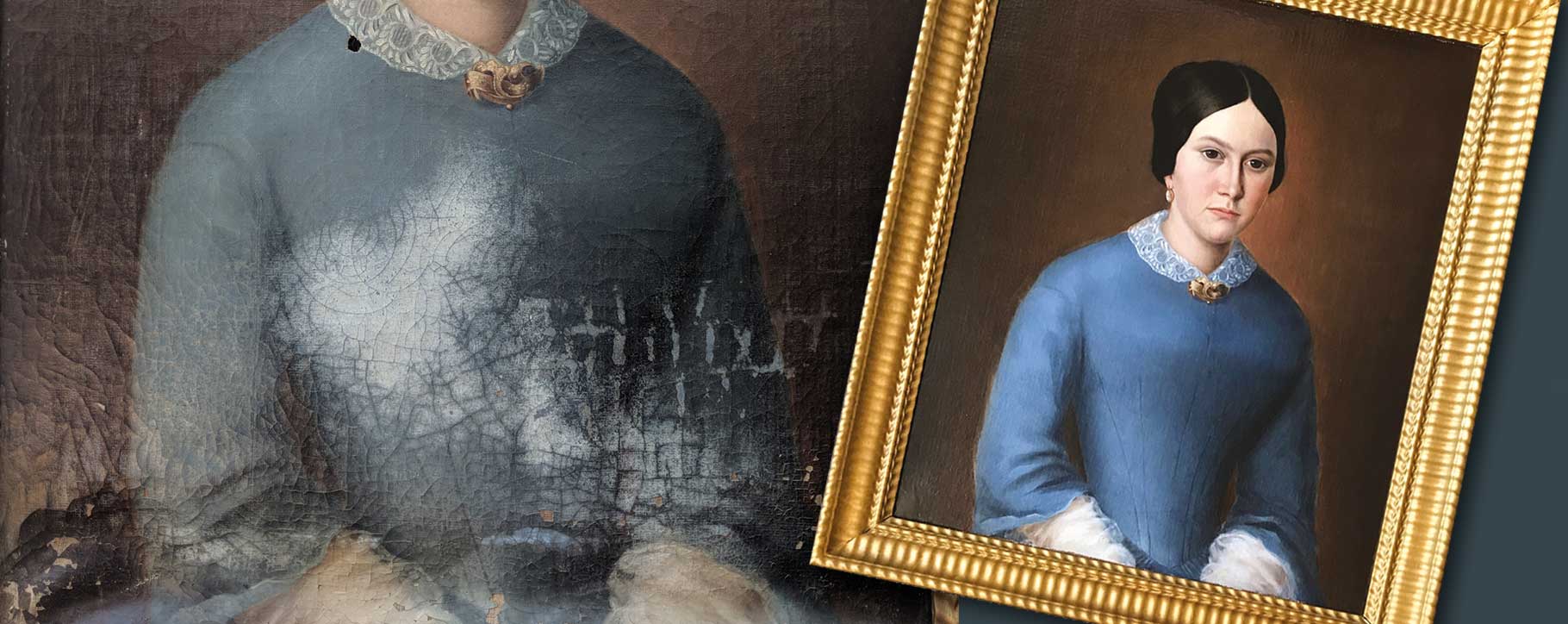 Above: an oil painting fully restored by our team following devastating water damage
Above: an oil painting fully restored by our team following devastating water damage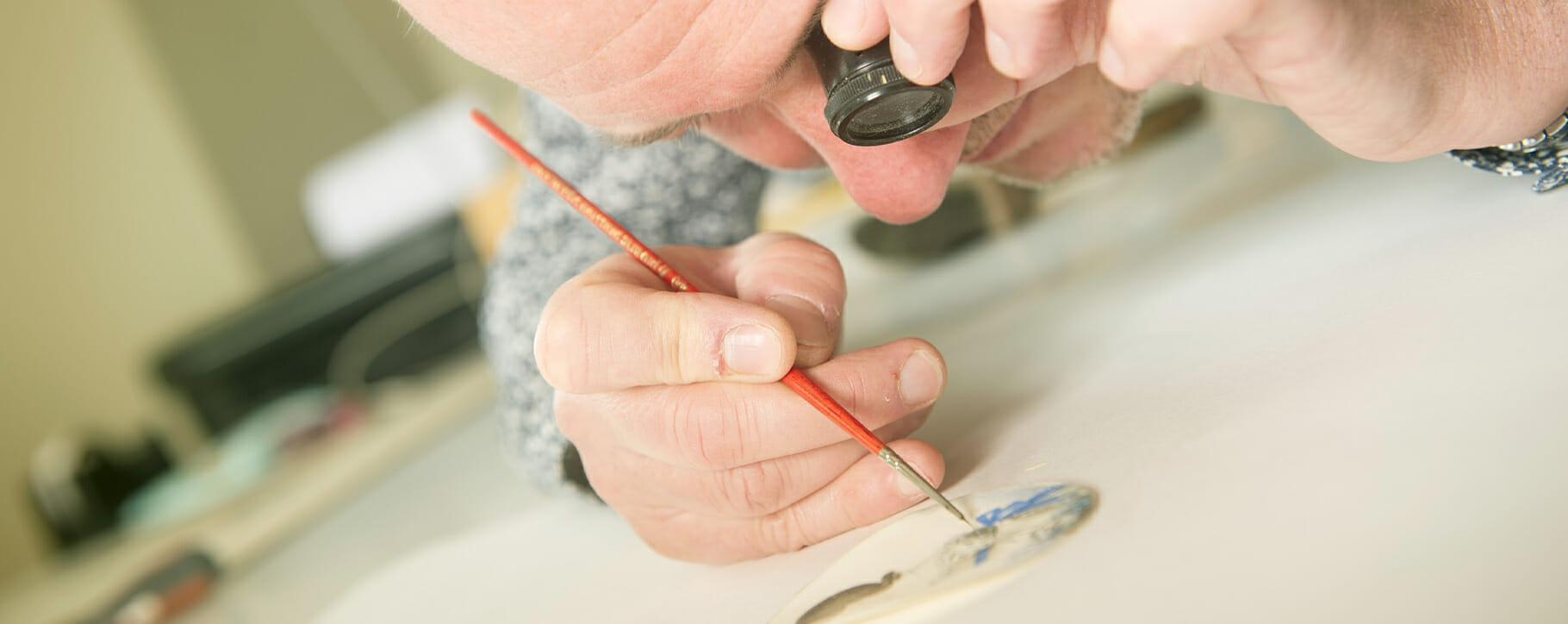 Above: our ICON accredited paper conservator working on a miniature watercolour portrait
Above: our ICON accredited paper conservator working on a miniature watercolour portrait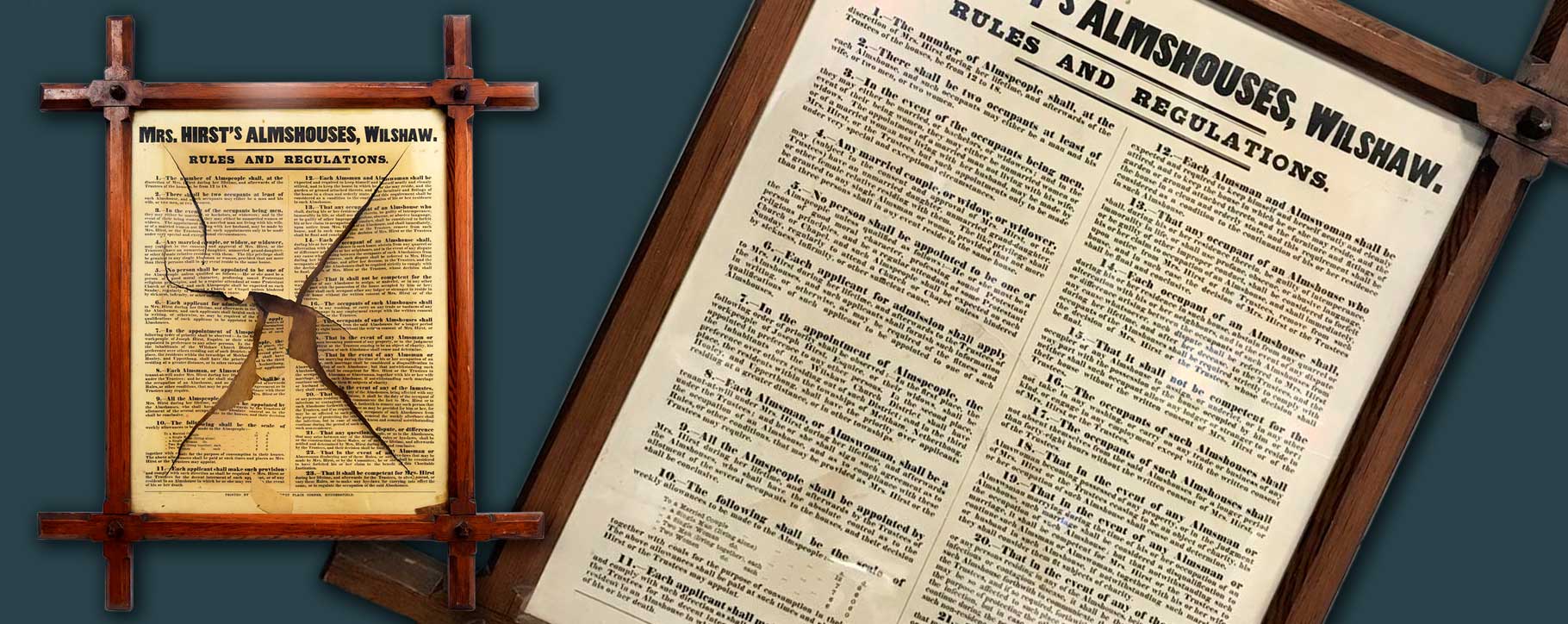 Above: a historically important almshouse rules document which was expertly restored by our paper conservator
Above: a historically important almshouse rules document which was expertly restored by our paper conservator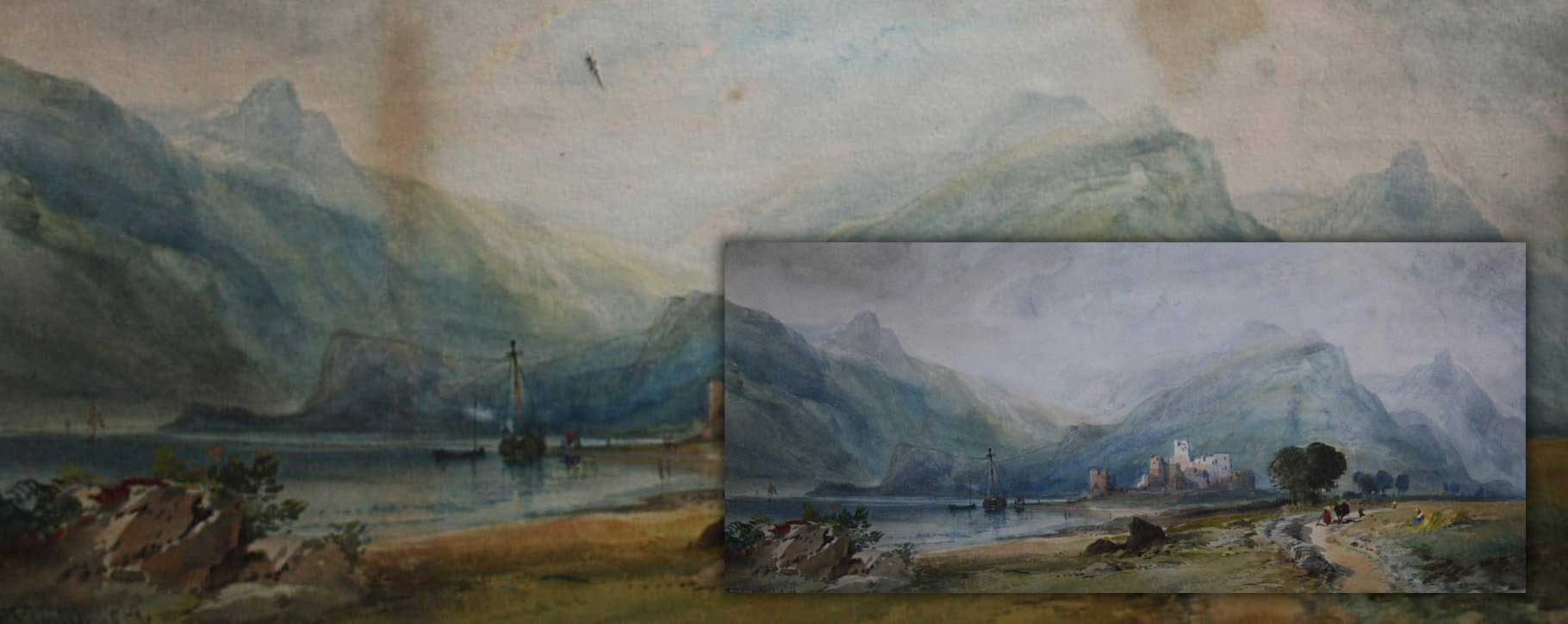 Above: a watercolour painting before and after restoration, including a tear repair and cleaning of discolouration caused by acidic framing materials
Above: a watercolour painting before and after restoration, including a tear repair and cleaning of discolouration caused by acidic framing materials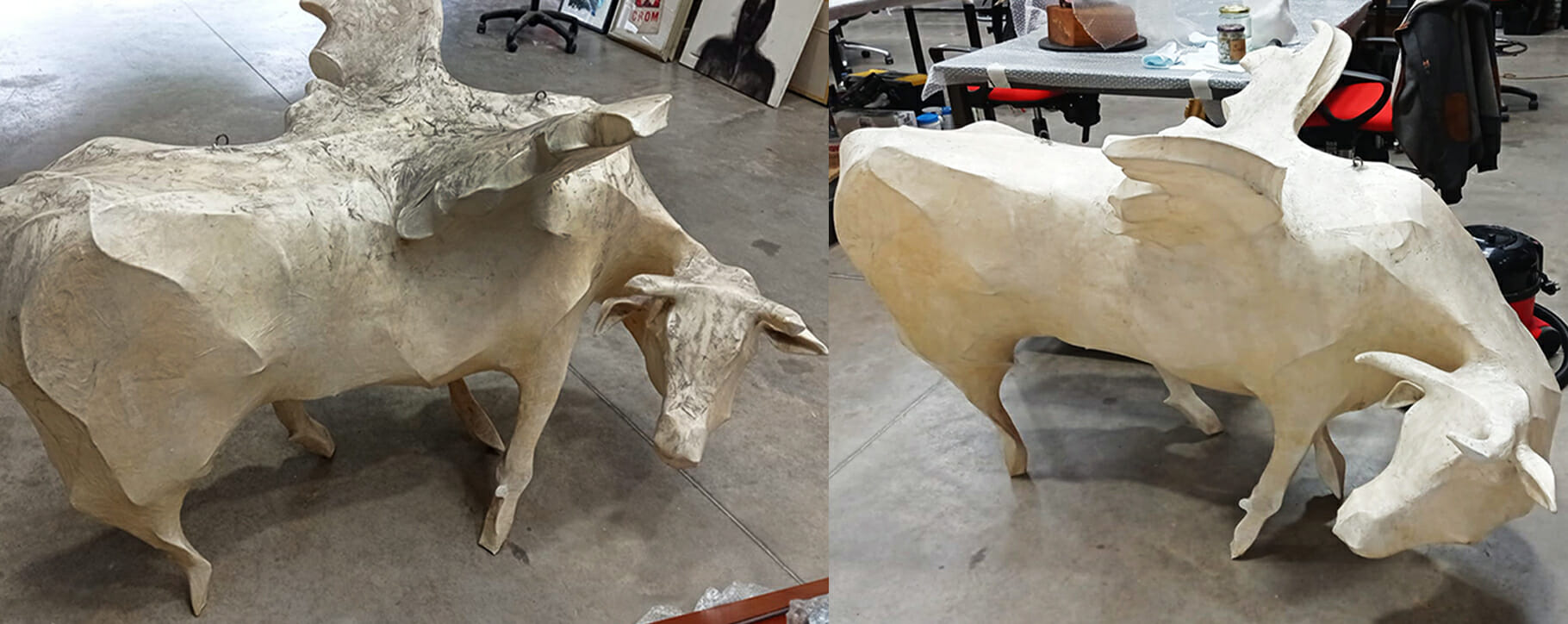 Above: a papier mache bull sculpture which was cleaned by our conservators allowing it to be returned to display free of dirt and debris
Above: a papier mache bull sculpture which was cleaned by our conservators allowing it to be returned to display free of dirt and debris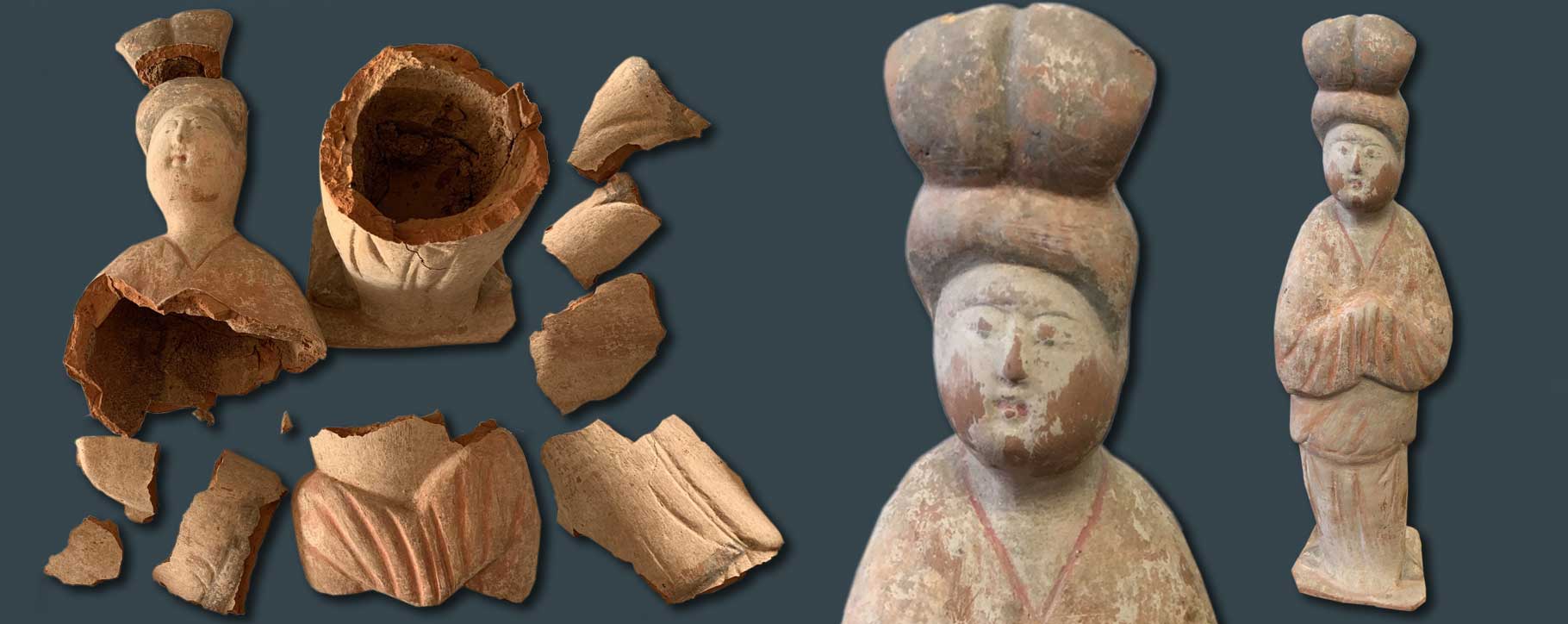 Above: a terracotta figure before and after restoration by our conservator
Above: a terracotta figure before and after restoration by our conservator Above: a selection of ceramics which have been restored by our specialist conservator
Above: a selection of ceramics which have been restored by our specialist conservator Above: a peacock tapestry restored by our specialist conservator, cleaning away contamination and mould damage
Above: a peacock tapestry restored by our specialist conservator, cleaning away contamination and mould damage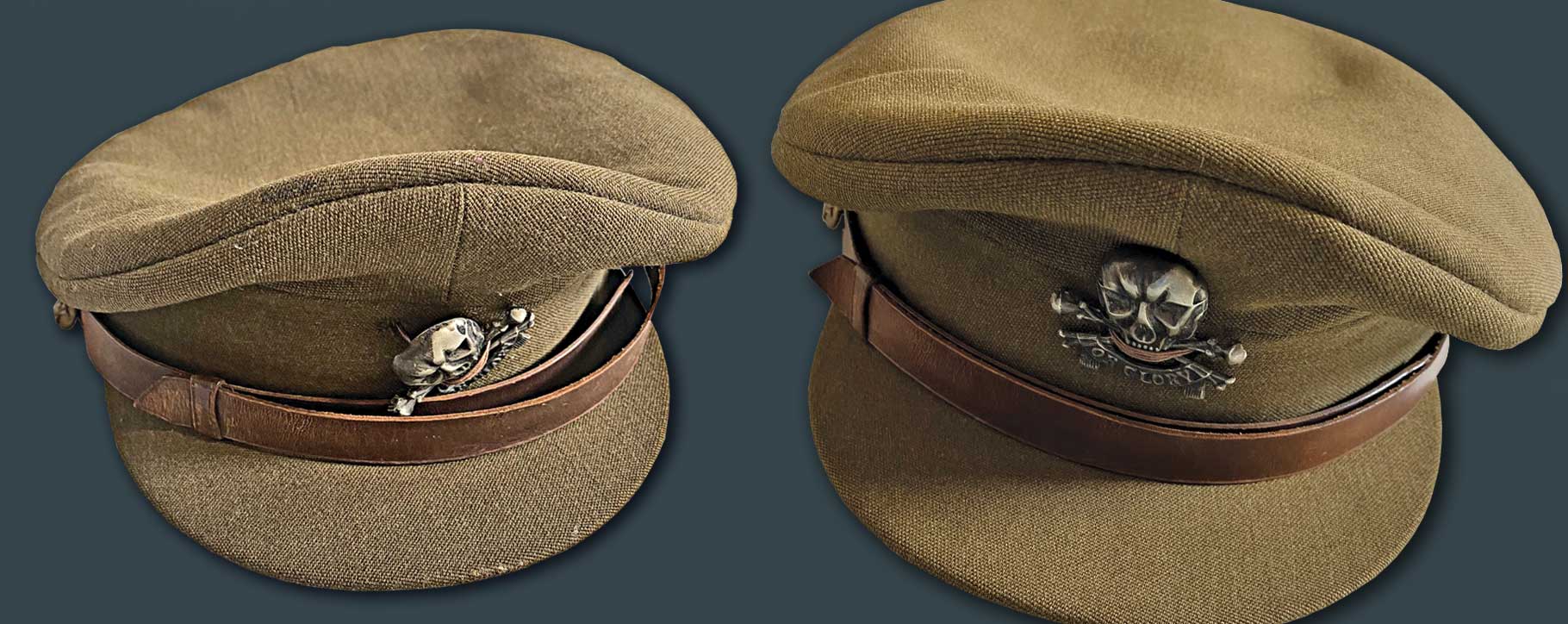 Above: an important military cap restored by our textiles conservator
Above: an important military cap restored by our textiles conservator Above: a frame restored by our conservator, including remoulded areas and reapplication of gilding
Above: a frame restored by our conservator, including remoulded areas and reapplication of gilding Above: our furniture conservators working with a variety of items in our studio
Above: our furniture conservators working with a variety of items in our studio




